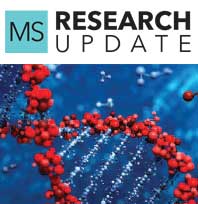Zeposia® (ozanimod)

In this Update
FDA-Approved Medications: Recently Approved
FDA-Approved Medications: Medications Recently Approved
Company: Bristol Myers Squibb
- Starting dose: 0.23 mg orally once daily on Days 1-4, followed by 0.46 mg orally on Days 5-7
- Maintenance dose: 0.92 mg orally once daily on Day 8 and thereafter
- Approved in March 2020 for relapsing forms of MS, including clinically isolated syndrome, relapsing-remitting disease, and active secondary-progressive disease, in adults.
Next: Bafiertam™ (monomethyl fumarate)
Zeposia® (ozanimod) is a sphingosine 1-phosphate (S1P1)-receptor modulator, meaning that it binds to two receptors – S1P1 and S1P5 – on the surface of cells.7 While the exact mechanism by which Zeposia exerts a therapeutic effect in MS is not completely understood, the medication’s impact may involve reducing the number of lymphocytes that migrate to the central nervous system (CNS), where lymphocytes may contribute to damaging the myelin sheath that protects nerves. This damage results in lesions, or areas of sclerosis (scarring/hardening), at different locations along the myelin sheath, giving rise to the term “multiple sclerosis.”
Two other S1P1-receptor modulators, Gilenya® (fingolimod) and Mayzent® (siponimod) are also approved by the FDA for treating MS. Additionally, Janssen/Johnson & Johnson has asked the FDA to approve another medication in this class, ponesimod, for the treatment of relapsing forms of MS in adults.
Zeposia is an oral medication taken once daily. The initial dose of 0.23 mg on Days 1-4 is followed by a dose of 0.46 mg on Days 5-7, with a once-daily dose of 0.92 mg starting on Day 8 and continuing thereafter.7 This approach to increasing the starting dose over a few days, which clinicians call “up-titration,” is necessary because some people starting Zeposia may experience initial but temporary decreases in heart rate and delays in the way electrical signals are transmitted in the heart.7
Before beginning Zeposia, people should have a complete blood count (CBC), an electrocardiogram (ECG), and liver function tests (which involve analyzing a sample of blood that can be obtained from the same blood draw performed for the CBC). Physicians are advised to consider what other medications a person is taking in order to be aware of any potential interactions between those medications and Zeposia. They also need to conduct an eye examination in patients with a history of certain ophthalmologic problems, and to vaccinate patients against varicella zoster virus (VZV) if their blood does not contain antibodies against that virus, which causes chickenpox and shingles.
Zeposia is contraindicated in people who in the last six months experienced a heart attack, stroke, coronary-related chest pain, or certain other cardiovascular conditions.7 Unlike other approved S1P1-receptor modulators, however, the FDA-approved prescribing information for Zeposia does not direct that people taking the medication be monitored after their first dose for possible cardiac issues.18
The FDA’s approval of Zeposia is based on data from two large Phase III trials, SUNBEAM and RADIANCE Part B, which together enrolled more than 2,600 people with MS. Both trials examined the safety and efficacy of Zeposia relative to Avonex® (interferon beta-1a). This interferon-based treatment is one of the first therapies approved for multiple sclerosis.18
In the two studies, people taking Zeposia had an annualized relapse rate (ARR) – a measure of the average number of relapses a group of patients will experience over the course of 12 months – of 0.18 at one year compared to 0.35 for Avonex, and of 0.17 versus 0.28 for Avonex over two years. Those rates translate into Zeposia providing a relative reduction in ARR of 48% at one year and 38% at two years compared to Avonex.7, 19, 20
Further, at one year, Zeposia reduced the number of T1-weighted gadolinium-enhanced brain lesions more than Avonex (0.16 vs 0.43), which is a relative reduction of 63%, and reduced the number of new or enlarging T2 lesions (1.47 vs. 2.84), which is a relative reduction of 48%.7, 20 At two years, Zeposia achieved a 53% relative reduction in T1-weighted gadolinium-enhanced brain lesions and a 42% relative reduction in new or enlarging T2 lesions, compared to the interferon-based therapy.7, 19
However, in two other measures examined in the trials – impact on three-month and six-month confirmed disability progression (CDP), there was not a statistically significant difference between patients in the Zeposia group and those in the Avonex group over the course of two years.7
In the Phase III clinical trials, the most common adverse reactions (occurring in 4% or more of people receiving Zeposia) were upper respiratory infection, liver enzyme elevations, a fall in blood pressure upon standing (orthostatic hypotension), urinary tract infection, back pain, and hypertension. Please note that in clinical trials, all adverse effects reported by study subjects are recorded; these events may or may not be related to the medication. This is why control or placebo groups are used to compare with groups receiving the experimental medication being studied.7
People who participated in SUNBEAM, RADIANCE Part B, and earlier, Phase II studies of Zeposia were eligible to enter an extension study assessing the long-term safety and efficacy of the medication. Researchers recently reported on an interim analysis of data on almost 2,500 patients who participated in that extension trial.
Among patients who took 1 mg of Zeposia in any of the earlier trials and who then continued that dose over an average of 19.2 months in the follow-up study, the ARR was 0.126. Meanwhile, people who had taken an interferon-based medication in an earlier trial and then switched to Zeposia in the extension study, had a very similar annualized relapse rate – 0.123 – over an average of 18.3 months in the follow-up study.
The incidence and nature of adverse events were similar to those seen in the Phase III studies. The most common adverse event during the extension study was nasopharyngitis (a cold or sore throat), which was reported by 11.3% of participants. Just under 6% of participants reported a serious treatment-emergent adverse event, and just over 1% of participants stopped participating in the study due to an adverse event.21
